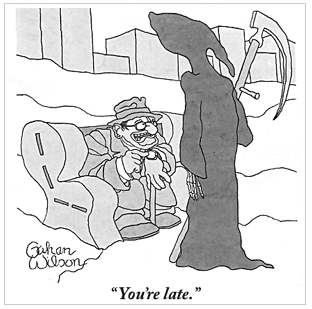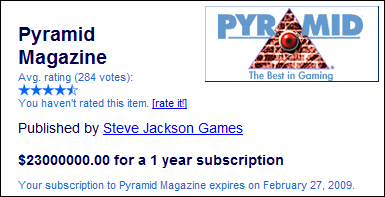'Let Us View Candy Land as a Mathematical Entity'
Game designer Greg Costikyan has written a detailed analysis of why Candy Land succeeds as a game in spite of the fact that winning the game is completely random and requires no strategy of any kind:
There are those who criticize Candy Land as being jejune and ultimately futile, since the nature of its rules construct and the (non-existent) emergent complexity it supports is utterly unsusceptible to any sort of rational analysis, or indeed, choice of player strategy.
... let us view Candy Land as a mathematical entity. It is very nearly a Markov chain, a stochastic process in which, given the current state, future states are independent of past states. (It would be a pure Markov chain if the deck were shuffled after each play; instead, it is a crippled Markov chain coupled to a push-pop stack.) As such, it is a metaphorical representation of the fundamental ideology of the United States; the past is no constraint on the future, and each individual should strive resolutely for personal advance despite whatever the past may hold.
Banking CEOs Deserve a Christmas Malus
I was scrounging through old bookmarks recently when I rediscovered World Wide Words, Michael Quinlan's online newsletter of unusual words. His current edition features "malus," a word that ought to be more common in American business given the disastrous mismanagement of many companies:
Though malus isn't in any general dictionary that I've consulted, it's also a fairly common term in the world of banking, insurance and contracts. A malus is the opposite of a bonus -- you might call it a forfeit or a clawback instead. It's receiving more attention as finance houses seek to rein in excessive payments to senior staff (it was in the news last week because the Swiss bank UBS has introduced malus provisions for its executives). It turns up in particular in the form bonus-malus system, for a contract that rewards success but penalises failure.
World's Oldest Person Dies (Again)
 One of the best jobs I ever had was working weekends on the state desk at the Fort Worth Star-Telegram during the late '80s. I took calls from correspondents across North Texas, wrote spot-news stories and spent the other 98 percent of my time reading everything on the news wire. That job had a lot in common with publishing the Drudge Retort today, with the notable exception that you once needed a journalism job to gorge on an all-you-can-eat buffet of wire stories.
One of the best jobs I ever had was working weekends on the state desk at the Fort Worth Star-Telegram during the late '80s. I took calls from correspondents across North Texas, wrote spot-news stories and spent the other 98 percent of my time reading everything on the news wire. That job had a lot in common with publishing the Drudge Retort today, with the notable exception that you once needed a journalism job to gorge on an all-you-can-eat buffet of wire stories.
When you read news for too long, you develop weird obsessions. Back then, I became the world's foremost expert on Paul Tsongas and Japanese sumo wrestling. Today, I've become fixated on how the AP reports the death of the world's oldest person.
The world's oldest person has a high mortality rate (tough job), and every time AP covers the story using the same formula: who kicked the bucket, how old was she down to the day, what was her secret for longevity, and who's now the oldest person. (I'm using the feminine pronoun because it's always a woman.)
On Thursday, Edna Parker gave up the ghost at 115 years and 220 days old. Born April 20, 1893, she was a mother and schoolteacher who never tried alcohol or tobacco, spent 69 years as a widow and offered "more education" as her best advice for living. The newest oldest person becomes Maria de Jesus of Portugal, also 115.
When the oldest person expires, it moves the living memory of the world past a certain number of historic events, a concept I've dubbed the Line of Oblivion. Although it's a grim notion, I check Wikipedia to see what crosses the line each time the oldest person croaks.
When Parker bought the farm and the line moved forward to de Jesus' birth on Sept. 10, 1893, we lost the last person who could have remembered the stock market crash of 1893 (May 5), Gandhi's first act of civil disobedience (June 7) and the Sea Islands Hurricane (Aug. 27).
We also lost anybody who could have been on the friend list of the German philosopher Jakob Froschammer (died June 14, 1893), Stanford University founder Leland Stanford (June 21) and the actress Georgiana Drew Barrymore (July 2), the mother of Lionel, Ethel and John.
If this line of thought is too macabre, I blame a childhood spent reading the cartoons of Gahan Wilson.
Customizing Apache Directory Listings with .htaccess
I was clearing off my desk today when I found an article I've been meaning to scan and send to somebody -- the story of how my friends almost elected a dalmatian and squirrel to the homecoming court of the University of North Texas in 1989. The alumni magazine wrote a feature on Hector the Eagle Dog and Agnes the Squirrel's campaign, which attracted national media and made a few of the human homecoming candidates very angry.
I can never tell when a file's too big to send in email without aggravating the recipient, so I upload files to my server and email the links instead. I decided to make this process easier by creating a clippings directory where uploaded files show up automatically.
The Apache web server can publish a listing of all files in a directory, as the official Apache site does in its images subdirectory. I wanted to make my clippings page look more like the rest of my weblog, so I found a tutorial on customizing directory listing pages.
First, I created an .htaccess file in the directory and turned directory indexing on with this command:
Options +Indexes
This command only works on servers that are configured to allow users to change options. For security reasons, I turn directory listings off by default, so they only appear when I specifically configure a directory to reveal its contents.
Next, I created header and footer web pages that contain the HTML markup to display above and below the directory listing. These files are identified by two more commands in .htaccess:
HeaderName header.html
ReadmeName footer.html
These web pages are located in the clippings directory. For the final step, I added a description of PDF documents and made sure that the header and footer files are not included in the listing:
AddDescription "PDF Document" .pdf
IndexIgnore header.html footer.html
There's a lot more that can be customized in an Apache directory listing, as the tutorial demonstrates, but for my project it seemed like overkill.
Update: Alternatively, I could've checked to see if the story was already online. Auugh.
Sharing Bookmarks and Feed Lists with XML
I'm working on a programming project that requires an XML format to represent bookmarks and other collections of URIs, but before I reinvent the wheel I'd like to see if there's an existing format that meets my goals. The format should be able to hold all of the following information:
- Bookmarks in web browsers
- Links in web directories like the Open Directory Project
- Feeds in an OPML subscription list
- Social bookmarks in Delicious
There are several potential formats that could be put to use: XBEL, the outline formats OPML and XOXO and the syndication formats RSS and Atom. Each has drawbacks, as I'll go over in upcoming posts here on Workbench.
I'm starting with XBEL, because that's the best-supported format specifically designed to hold bookmarks. XBEL was created in 1998 by members of the Python community led by Fred L. Drake Jr. XBEL 1.0 continues to be the only release, though there's occasional talk on the XBEL-Specs mailing list about developing a new version.
XBEL was designed to represent browser bookmarks and has become the native format for storing them in the Konqueror and Galeon browsers. There are add-ons that extend XBEL support to more popular browsers -- one example is SyncPlaces, a Firefox add-on that can manually import and export XBEL bookmarks.
Here's what a bookmark looks like in XBEL data produced by SyncPlaces:
<bookmark id="row123" added="2008-11-25T17:30:22.352" modified="2008-11-25T17:30:22.522" href="https://workbench.cadenhead.org/">
<title>Workbench</title>
<info>
<metadata owner="Mozilla" dateadded="1227634222352963" lastmodified="1227634222522963"/>
</info>
<desc>Rogers Cadenhead's personal weblog</desc>
</bookmark>
Bookmarks in XBEL can be grouped into folders, which themselves can contain more folders to create a hierarchy. The format's well-designed and can be extended by namespaces or the metadata element, which in the preceding example carries Firefox-specific information.
There are several drawbacks to using XBEL. The format predates social bookmarking and lacks support for tagging bookmarks or assigning them to categories like the ones employed by the Open Directory Project.
XBEL also predates the popularity of syndication, so there's no way to identify that bookmarks are RSS or Atom feeds. You also can't establish a relationship between a web site's home page and its feed. A few years ago on XBEL-Specs I floated the idea of adding type and rel attributes to bookmarks that function like they do in Atom, which would be all that's required to publish blogrolls and feed subscription lists with the format.
XBEL can't be used for web directories, feed lists or social bookmarks without extending the format. I think all three are strong enough use cases to be part of a bookmark format's core set of elements. If I choose XBEL, most of my project's functionality won't be supported by today's XBEL tools or client libraries, which is the primary reason to adopt an existing format.
Jeff Bridges Visits the Dentist
 The actor Jeff Bridges passes along a fish tale I hadn't heard before, concerning a fisherman in Wichita, Kan., who saw a basketball behaving oddly in a lake:
The actor Jeff Bridges passes along a fish tale I hadn't heard before, concerning a fisherman in Wichita, Kan., who saw a basketball behaving oddly in a lake:
It turned out to be a flathead catfish who had obviously tried to swallow a basketball which became stuck in its mouth!!
The fish was totally exhausted from trying to dive, but unable to because the ball would always bring him back up to the surface.
Bill tried numerous times to get the ball out, but was unsuccessful. He finally had his wife, Pam, cut the ball in order to deflate it and release the hungry catfish.
The story appears to be legit, according to About.Com's Urban Legends site.
The tale led me to Bridges' blog, which he publishes entirely in the form of doodles. His October update includes this drawing from his most recent dental cleaning, where his hygienist offered him a headlines and "pretty images + music or a dose of terror." He chose terror.
Bridges' doodles make particularly inspired use of hyperlinks, such as the one that promotes his upcoming-in-2010 film Men Who Stare at Goats. "Click goat droppings for information," he urges.
Most Expensive Magazine Subscription Ever
I subscribe to Pyramid, a roleplaying game magazine published for the past 15 years by Steve Jackson Games. The company keeps track of past orders so you can redownload issues in PDF format. I found a surprise when I checked my subscription today.

That's probably a bit more than I should have spent, but the deduction will make it a lot easier to pay my 2008 taxes.

